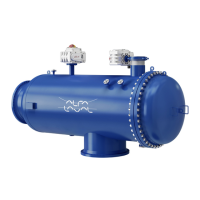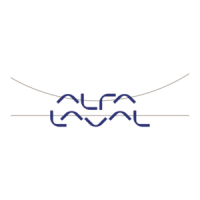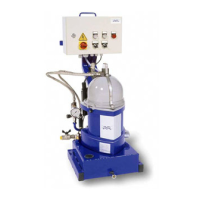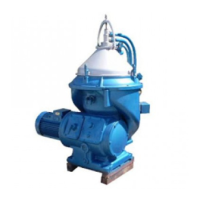Do you have a question about the Alfa Laval P 605 and is the answer not in the manual?
Guidance on safety precautions for the separator.
Explains the purpose and principles of separation.
Details the separator's construction and operational components.
Provides guidance for operating the separator.
Instructions for maintenance, disassembly, and reassembly.
Hazards related to component failure due to speed or material stress.
Risks of being caught by moving parts during operation or maintenance.
Covers electrical, crush, noise, burn, skin, and cut hazards.
Risks from ejected parts and inhaling dust.
Defines danger, warning, caution, and note symbols.
Guidelines for unpacking and maintenance waste disposal.
Defines skilled and instructed person requirements.
Safety considerations for remote operation.
Overview of the purpose of separation.
Explains separation using gravitational force.
Explains separation using centrifugal force.
Discusses the effect of temperature on separation efficiency.
Describes the separator's overall design and how it works.
Explains the basic working principle of the separation process.
Details the liquid flow and separation mechanism within the bowl.
Explains the function and importance of the water seal.
Describes the process of displacing oil for sludge discharge.
Explains the role and selection of the gravity disc.
Describes the clarifier disc used in clarification mode.
Details how sludge is discharged from the bowl.
Explains bowl opening and closing for sludge discharge.
Explains how power is transmitted to the bowl.
Describes sensors and indicators on the separator.
Definition of intermediate maintenance service.
Definition of major maintenance service.
Definition of liquid/liquid/solids separation.
Definition of sludge ejection.
Guidelines for regular maintenance activities.
Recommended intervals for maintenance tasks.
Details of intermediate service tasks and frequency.
Details of major service tasks and frequency.
Specifies tasks for 3-year service.
Step-by-step guide for performing maintenance.
Information on available service kits.
Routine checks and logs for maintenance.
Inspection points for intermediate service.
Inspection points for major service.
Specific tasks for the 3-year service.
Step-by-step guide for lifting the separator.
Guidelines for cleaning the separator exterior.
Step-by-step guide for changing the oil.
General lubrication points and intervals.
Methods for analyzing and managing vibration.
Information on bearings and shutdown procedures.
Guidance on referencing check points in the manual.
Lists tools needed for dismantling and assembly.
Identification of components for inlet/outlet and bowl.
Steps for dismantling the inlet/outlet and bowl.
Steps for assembling the inlet/outlet and bowl.
Information regarding the bowl spindle and frame.
Steps for dismantling the bowl spindle and frame.
Steps for assembling the bowl spindle and frame.
Information on the friction coupling.
Steps for dismantling the friction coupling.
Steps for assembling the friction coupling.
Procedures for changing the belt.
Procedures for dismantling and assembling the oil filling device.
Procedure for removing the water tank.
Information regarding the brake system.
Procedure for mounting new frame feet.
Overview of the separator's specifications and application.
Statements of compliance with relevant directives and standards.
Detailed technical specifications of the separator.
Lists connections and their requirements/limits.
Diagrams showing overall dimensions and mounting points.
Details on nominal dimensions and installation of connections.
Information on operational procedures and signal processing.
Details on electrical and fluid connections.
Required conditions for operating water quality.
Diagrams showing foundation requirements and dimensions.
Diagram showing interconnection of components.
Technical details for electric motors.
Graphs showing performance characteristics.
Information on machine plates and safety labels.
Specifications for storage and installation.
Storage conditions and protection recommendations.
Procedures for storing the separator when not in use.
Actions required before starting the separator.
Guidelines for connecting to external systems.
Procedures for cleaning and starting after storage.
Specifications for storing and transporting goods.
Specification for separator transport.
Requirements for space and measurements during installation planning.
Requirements for foundation strength and fitting the frame.
Describes procedures for starting, running, and stopping the separator.
Procedures for managing the operating water interface in clarifier mode.
Procedures for managing the operating water interface in purifier mode.
Guidance on selecting gravity discs for purification.
Examples for gravity disc selection using nomograms.
Ensuring correct installation and flushing before initial start.
Pre-start checks and procedures after performing service.
Steps for starting and running the separator.
Regular checks to perform during the separation process.
Procedure for safely stopping the separator.
Procedure for stopping the separator due to excessive vibration.
Actions required after a safety or emergency stop.
Guidance on safety precautions for the separator.
Explains the purpose and principles of separation.
Details the separator's construction and operational components.
Provides guidance for operating the separator.
Instructions for maintenance, disassembly, and reassembly.
Hazards related to component failure due to speed or material stress.
Risks of being caught by moving parts during operation or maintenance.
Covers electrical, crush, noise, burn, skin, and cut hazards.
Risks from ejected parts and inhaling dust.
Defines danger, warning, caution, and note symbols.
Guidelines for unpacking and maintenance waste disposal.
Defines skilled and instructed person requirements.
Safety considerations for remote operation.
Overview of the purpose of separation.
Explains separation using gravitational force.
Explains separation using centrifugal force.
Discusses the effect of temperature on separation efficiency.
Describes the separator's overall design and how it works.
Explains the basic working principle of the separation process.
Details the liquid flow and separation mechanism within the bowl.
Explains the function and importance of the water seal.
Describes the process of displacing oil for sludge discharge.
Explains the role and selection of the gravity disc.
Describes the clarifier disc used in clarification mode.
Details how sludge is discharged from the bowl.
Explains bowl opening and closing for sludge discharge.
Explains how power is transmitted to the bowl.
Describes sensors and indicators on the separator.
Definition of intermediate maintenance service.
Definition of major maintenance service.
Definition of liquid/liquid/solids separation.
Definition of sludge ejection.
Guidelines for regular maintenance activities.
Recommended intervals for maintenance tasks.
Details of intermediate service tasks and frequency.
Details of major service tasks and frequency.
Specifies tasks for 3-year service.
Step-by-step guide for performing maintenance.
Information on available service kits.
Routine checks and logs for maintenance.
Inspection points for intermediate service.
Inspection points for major service.
Specific tasks for the 3-year service.
Step-by-step guide for lifting the separator.
Guidelines for cleaning the separator exterior.
Step-by-step guide for changing the oil.
General lubrication points and intervals.
Methods for analyzing and managing vibration.
Information on bearings and shutdown procedures.
Guidance on referencing check points in the manual.
Lists tools needed for dismantling and assembly.
Identification of components for inlet/outlet and bowl.
Steps for dismantling the inlet/outlet and bowl.
Steps for assembling the inlet/outlet and bowl.
Information regarding the bowl spindle and frame.
Steps for dismantling the bowl spindle and frame.
Steps for assembling the bowl spindle and frame.
Information on the friction coupling.
Steps for dismantling the friction coupling.
Steps for assembling the friction coupling.
Procedures for changing the belt.
Procedures for dismantling and assembling the oil filling device.
Procedure for removing the water tank.
Information regarding the brake system.
Procedure for mounting new frame feet.
Overview of the separator's specifications and application.
Statements of compliance with relevant directives and standards.
Detailed technical specifications of the separator.
Lists connections and their requirements/limits.
Diagrams showing overall dimensions and mounting points.
Details on nominal dimensions and installation of connections.
Information on operational procedures and signal processing.
Details on electrical and fluid connections.
Required conditions for operating water quality.
Diagrams showing foundation requirements and dimensions.
Diagram showing interconnection of components.
Technical details for electric motors.
Graphs showing performance characteristics.
Information on machine plates and safety labels.
Specifications for storage and installation.
Storage conditions and protection recommendations.
Procedures for storing the separator when not in use.
Actions required before starting the separator.
Guidelines for connecting to external systems.
Procedures for cleaning and starting after storage.
Specifications for storing and transporting goods.
Specification for separator transport.
Requirements for space and measurements during installation planning.
Requirements for foundation strength and fitting the frame.
Describes procedures for starting, running, and stopping the separator.
Procedures for managing the operating water interface in clarifier mode.
Procedures for managing the operating water interface in purifier mode.
Guidance on selecting gravity discs for purification.
Examples for gravity disc selection using nomograms.
Ensuring correct installation and flushing before initial start.
Pre-start checks and procedures after performing service.
Steps for starting and running the separator.
Regular checks to perform during the separation process.
Procedure for safely stopping the separator.
Procedure for stopping the separator due to excessive vibration.
Actions required after a safety or emergency stop.
| Model | P 605 |
|---|---|
| Category | Water Filtration Systems |
| Manufacturer | Alfa Laval |
| Max Operating Pressure | 10 bar (145 psi) |
| Housing Material | Stainless steel |











